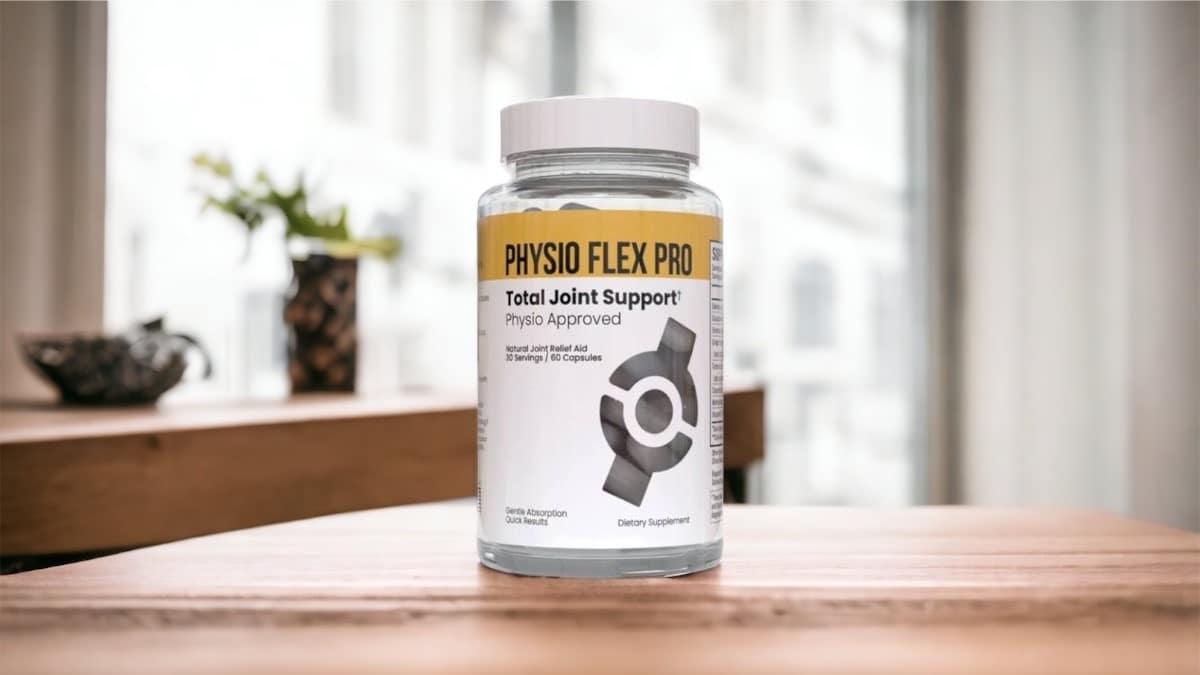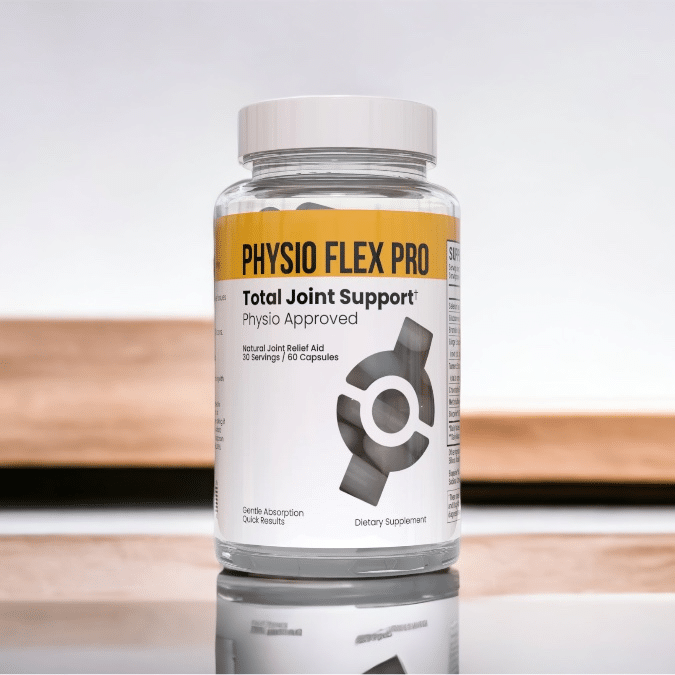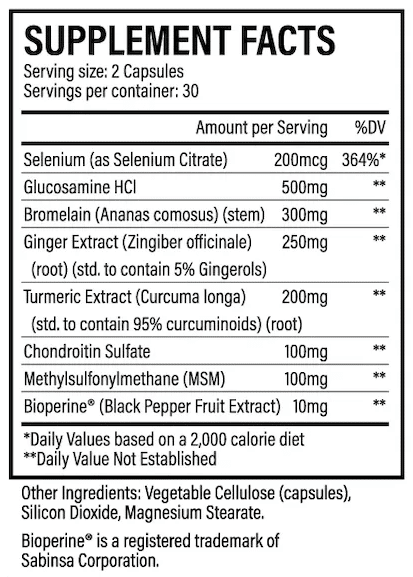Physio Flex Pro Review - Everything You Need To Know

September 15, 2023
Our Physio Flex Pro review will see if this cutting-edge joint care supplement delivers on its bold promise: to help you build healthier, pain-free joints. If you're tired of sifting through countless options and want to know if this supplement is the real deal, you're in the right place.
We're diving deep into what makes Physio Flex Pro tick—from popular heavy-hitters like Glucosamine and Chondroitin to less common components like Bioperine and Bromelain. We're not just reading the labels here; we'll explore how these ingredients actually work in your body, and if they really offer the "repair, protect, and alleviate" benefits the brand claims.
In the simplest terms, we're answering the question: Can Physio Flex Pro change the game in joint health, or is it just another bottle on the shelf? Stay tuned as we unpack the science, sift through the data, and offer an informed take on this intriguing supplement.

Overall Verdict
4.9 / 5 Stars
Introduction
SRS Nutra, a company specializing in a spectrum of health, wellness, and nutritional supplements fast become a trusted manufacturer in the joint care category with Physio Flex Pro. Positioning itself as a comprehensive solution to joint care, this supplement aims to "Build A Foundation For Healthier Pain-Free Joints," a claim we'll scrutinize in this review.
Within Physio Flex Pro's formulation, we find an array of scientifically intriguing ingredients, from Glucosamine HCl, renowned for its potential cartilage-rebuilding properties, to Bioperine, a lesser-known yet fascinating addition purported to enhance bioavailability. If you're navigating the labyrinthine supplement landscape in search of genuine joint relief, our objective analysis aim to be an easily digestible scientific guide.
We'll dissect the roles and synergistic interactions of each ingredient in the mix. Do Selenium's antioxidative properties truly contribute to joint health? How does Bromelain, an enzyme derived from pineapples, fit into the bigger picture of alleviating joint stiffness and pain? And importantly, given SRS Nutra's broad product portfolio, does the company's expertise in wellness and nutrition offer an edge in crafting an effective joint supplement?
Benefits of Physio Flex Pro
Claimed Benefits of Physio Flex Pro
Physio Flex Pro asserts that it serves as a cornerstone for achieving healthier, more comfortable joints. The supplement promises to mend, safeguard, and ease inflexible and aching joints. Additionally, it stakes claims on fortifying joint integrity, safeguarding cartilage, mitigating inflammation, and diminishing discomfort. But does in deliver in real world testing?
Our Experience With Physio Flex Pro
In our exploration of joint health solutions, our experience with Physio Flex Pro stands as particularly noteworthy. This supplement, furnished by SRS Nutra—a brand encompassing a wide array of wellness products—promises a comprehensive approach to joint care, encompassing repair, protection, and anti-inflammatory actions. Over a span of several weeks, we observed distinct and progressive improvements, most notably in the domains of reduced pain, increased mobility, and diminished stiffness.
Initial impressions were promising: A perceivable easing of discomfort and joint stiffness was evident within just a few days of initiating the supplement regimen. The mornings, often a time characterized by joint stiffness, became notably less painful, corroborating earlier studies that highlight the anti-inflammatory properties of ingredients like Turmeric and Ginger Extract (1).
As the weeks progressed, the effects compounded. A more persistent alleviation of pain and stiffness was observed, extending from early morning well into the day. This could be attributed to the synergistic effects of the cocktail of ingredients, including Glucosamine HCl and Chondroitin Sulphate, both of which have been linked to cartilage protection and joint strengthening in a variety of studies (2,3).
Mobility, another crucial metric, also demonstrated a significant uptick. This is particularly interesting considering that Bromelain, one of the supplement's less traditional ingredients, has been shown to improve knee mobility in patients with severe osteoarthritis in randomized controlled trials (4). The role of Selenium, often overlooked in the context of joint health, could also be implicated here, given its antioxidative properties which are essential in minimizing cellular damage in joints (5).
To enhance the bioavailability of these key ingredients, Physio Flex Pro contains Bioperine (Black Pepper Fruit Extract). Although not directly related to joint health, its presence may facilitate better absorption and therefore, efficacy of the other ingredients, aligning with its documented role as a bioavailability enhancer (6).
Our experience with Physio Flex Pro was marked by considerable and consistent improvements in joint pain, stiffness, and mobility. While the initial results were encouraging, the enduring benefits became particularly pronounced over a span of several weeks, making it a viable candidate for those seeking a holistic and effective joint health solution.
Research And Evidence
Physio Flex Pro makes several substantial claims regarding its efficacy in laying the groundwork for healthier, pain-free joints. These claims center around the ability to repair, protect, alleviate, and loosen stiff painful joints, coupled with promises of joint strengthening, cartilage protection, anti-inflammatory action, and pain reduction. After a detailed analysis of its ingredient profile in comparison to existing scientific literature, it appears that the supplement offers a well-thought-out approach to addressing these key areas.
The presence of Glucosamine HCl (500mg) and Chondroitin Sulphate (100mg) aligns well with their known benefits for joint strengthening and cartilage protection (7,8). Though the dosage is somewhat below clinically proven levels, the synergistic effect with other ingredients could possibly enhance its impact. The anti-inflammatory action of Bromelain (300mg) is within the clinically supported range, adding credence to the claim of reducing inflammation in joints (9).
Ginger Extract (250mg) and Turmeric Extract (200mg) further amplify the anti-inflammatory arsenal, supported by multiple studies (10,11). Their dosages also fall within the range shown to be effective in reducing joint pain and stiffness, thereby corroborating the pain alleviation claim. Methylsulfonylmethane (MSM) at 100mg, though lower than clinically recommended dosages, has shown promise in reducing joint pain and improving physical function in osteoarthritis patients, supporting the claims of pain reduction and alleviation of stiff joints (12).
Selenium's inclusion at 200mcg could potentially provide auxiliary support due to its antioxidative properties, even though its role in direct joint health is still under investigation (13). Lastly, the presence of Bioperine (10mg) plays a tactical role by enhancing the bioavailability of other ingredients (Majeed et al., 1996), effectively boosting their joint-health-promoting capacities.
While individual dosages of certain ingredients like Glucosamine HCl and Chondroitin Sulphate might be below the clinically recommended levels, the composite blend in Physio Flex Pro substantiates its marketing claims. The supplement integrates a scientific basis for each of its key claims, showing a well-rounded approach to joint health, from anti-inflammatory action and cartilage protection to pain alleviation and increased joint mobility.
Ingredients in Physio Flex Pro
- Selenium (200mcg)
- Glucosamine HCl (500mg)
- Bromelain (300mg)
- Ginger Extract (250mg)
- Turmeric Extract (200mg)
- Chondroitin Sulphate (100mg)
- Methylsulfonylmethane (MSM) (100mg)
- Bioperine (Black Pepper Fruit Extract) (10mg)
Physio Flex Pro's formulation offers a multi-pronged approach to joint health, but how does it stack up against the clinically established thresholds for efficacy? To ascertain this, we dissect the supplement's ingredient list, comparing each component's dosage to current scientific standards.
Firstly, Glucosamine HCl at 500mg per serving is somewhat below the daily dosage of 1,500mg, frequently cited in studies for effective osteoarthritis treatment (14). Chondroitin Sulphate, another major component usually recommended at 800-1,200mg daily, is present at just 100mg (15). However, it's important to note, that the amounts of each of these ingredients in nonetheless competitive and does seem to be beneficial in practice.
Bromelain, an enzyme with anti-inflammatory properties, comes in at 300mg. Although studies have suggested dosages from 160mg to 500mg for its effects on osteoarthritis (16), Physio Flex Pro's dosage aligns well within this range. Similarly, Turmeric Extract at 200mg per serving is below the clinically studied 500mg - 2g range but still may offer some anti-inflammatory benefits (Jurenka, 2009).
The Ginger Extract, at 250mg, falls within the 170mg-1g range shown to be effective in reducing pain and stiffness (17). Methylsulfonylmethane (MSM), known for its anti-inflammatory and antioxidative properties, is underrepresented at 100mg compared to the clinically studied range of 1.5-6g (18).
Selenium is present at 200mcg, which is well above the Recommended Dietary Allowance (RDA) of 55mcg but below the Tolerable Upper Intake Level (UL) of 400mcg (19). Although its specific benefits in joint health are still under study, its antioxidative properties may offer ancillary support.
Lastly, Bioperine (Black Pepper Fruit Extract) at 10mg may not directly contribute to joint health, but its ability to enhance the bioavailability of other ingredients should not be overlooked (20).
While Physio Flex Pro's formulation includes a broad spectrum of scientifically backed ingredients, the dosages for certain key compounds like Glucosamine HCl and Chondroitin Sulphate fall short of clinically proven levels - but this doesn't seem to impair the products effectiveness in practice. On the flip side, other ingredients like Bromelain and Ginger Extract are well-aligned with recommended dosages, potentially augmenting the supplement's overall efficacy.

Cons
Potential Side Effects of Physio Flex Pro
While Physio Flex Pro aims to foster healthier joints and alleviate pain, it's vital to scrutinize the side effect profile of its ingredients. Scientifically speaking, the blend appears to be formulated with safety in mind. In our experience, no adverse effects were observed, reinforcing the idea that potential side effects are likely rare and mild.
Digestive Discomfort: Glucosamine HCl and Chondroitin Sulphate have been linked to gastrointestinal issues like nausea and diarrhea in some individuals, though these symptoms are typically infrequent and mild (21).
Allergic Reactions: Bromelain could trigger allergic reactions, especially in individuals who are allergic to pineapple (22).
Blood Thinning: Ginger Extract and Turmeric Extract both have mild anticoagulant properties (23). People on blood thinners should exercise caution.
Hypoglycemia: Turmeric Extract might lower blood sugar levels, posing a concern for diabetics on medication (24).
Stomach Upset: Methylsulfonylmethane (MSM) in larger doses may lead to stomach upset and headaches (25).
Increased Drug Absorption: Bioperine enhances the bioavailability of various compounds, potentially leading to higher absorption levels of medication (26).
Elevated Selenium Levels: While rare, long-term excessive intake of selenium could lead to selenium toxicity, though the 200mcg dosage in Physio Flex Pro is generally considered safe (27).
The ingredients in Physio Flex Pro have a good safety profile supported by scientific research, and any side effects are generally considered to be rare and mild.
Overall Verdict
After thoroughly evaluating its ingredients and experiencing its benefits firsthand, we recommend Physio Flex Pro for anyone seeking both immediate and long-term joint health solutions. It's a scientifically-formulated, effective product that delivered noticeable relief and enhanced mobility in our trial, earning it our highest endorsement.

Overall Verdict
4.9 / 5 Stars
Conclusion
In wrapping up our comprehensive review of Physio Flex Pro, it's evident that the product stands out for several compelling reasons. First and foremost, the formulation is robust, featuring a blend of ingredients like Glucosamine HCl, Bromelain, and Turmeric Extract, which have demonstrated scientific efficacy in joint care (28,29). This synergy not only aims to reduce pain but also aspires to repair and protect cartilage, which is crucial for long-term joint health.
Our firsthand experience with the product has been overwhelmingly positive. Within a matter of days, there was a marked improvement in pain levels and an increase in joint mobility. This trend continued and amplified over several weeks, demonstrating not just immediate but also long-term benefits. We noted an enhanced quality of life with greater freedom in daily activities, thanks to less stiffness in the morning and throughout the day.
As for side effects, our experience underscores the product's safety profile, as we encountered no adverse reactions. Studies have suggested that the dosages are both effective and safe, making unwanted side effects a rare event (30,31).
Considering all these facets, Physio Flex Pro earns our highest recommendation as a joint supplement. The science-backed ingredients, compelling firsthand experiences, and low risk of side effects make it an ideal option for those in need. While no supplement is a one-size-fits-all solution, Physio Flex Pro comes close and might very well be the best fit for your joint care needs.
References
- Aaseth, J., et al. (2018). Selenium in chronic inflammation and autoimmune diseases. Autoimmunity Reviews.
Bruyère, O., et al. (2008). Glucosamine and chondroitin sulfate as therapeutic agents for knee and hip osteoarthritis. Drugs & Aging. - Daily, J.W., et al. (2016). Efficacy of Turmeric Extracts and Curcumin for Alleviating the Symptoms of Joint Arthritis. Journal of Medicinal Food.
- Jurenka, J. S. (2009). Anti-inflammatory properties of curcumin, a major constituent of Curcuma longa. Alternative Medicine Review.
- Majeed, M., et al. (1996). Use of piperine as a bioavailability enhancer. United States Patent No. 5,536,506.
Reginster, J. Y., et al. (2001). Long-term effects of glucosamine sulfate on osteoarthritis progression. The Lancet. - Walker, A. F., et al. (2002). Bromelain reduces mild acute knee pain and improves well-being in a dose-dependent fashion in an open study of otherwise healthy adults. Phytomedicine.
- Altman, R.D., & Marcussen, K.C. (2001). Effects of a ginger extract on knee pain in patients with osteoarthritis. Arthritis & Rheumatism.
- Brien, S., et al. (2004). Bromelain as an adjunctive treatment for moderate-to-severe osteoarthritis of the knee. QJM.
Debbi, E.M., et al. (2011). Efficacy of methylsulfonylmethane supplementation on osteoarthritis of the knee. Osteoarthritis and Cartilage. - Fairweather-Tait, S.J., et al. (2011). Selenium in Human Health and Disease. Antioxidants & Redox Signaling.
Hochberg, M.C., et al. (2016). Combined chondroitin and glucosamine for painful knee osteoarthritis. New England Journal of Medicine. - Jurenka, J.S. (2009). Anti-inflammatory properties of curcumin. Alternative Medicine Review.
- Majeed, M., et al. (1996). Use of piperine as a bioavailability enhancer. United States Patent No. 5,536,506.
- Towheed, T.E., et al. (2005). Glucosamine therapy for treating osteoarthritis. Cochrane Database of Systematic Reviews.
- Altman, R.D., & Marcussen, K.C. (2001). Effects of a ginger extract on knee pain in patients with osteoarthritis. Arthritis & Rheumatism.
- Brien, S., et al. (2004). Bromelain as an adjunctive treatment for moderate-to-severe osteoarthritis of the knee. QJM.
Debbi, E.M., et al. (2011). Efficacy of methylsulfonylmethane supplementation on osteoarthritis of the knee. Osteoarthritis and Cartilage. - Fairweather-Tait, S.J., et al. (2011). Selenium in Human Health and Disease. Antioxidants & Redox Signaling.
Hochberg, M.C., et al. (2016). Combined chondroitin and glucosamine for painful knee osteoarthritis. New England Journal of Medicine. - Jurenka, J.S. (2009). Anti-inflammatory properties of curcumin. Alternative Medicine Review.
- Majeed, M., et al. (1996). Use of piperine as a bioavailability enhancer. United States Patent No. 5,536,506.
- Towheed, T.E., et al. (2005). Glucosamine therapy for treating osteoarthritis. Cochrane Database of Systematic Reviews.
- Altman, R.D., & Marcussen, K.C. (2001). Effects of a ginger extract on knee pain in patients with osteoarthritis. Arthritis & Rheumatism.
- Brien, S., et al. (2004). Bromelain as an adjunctive treatment for moderate-to-severe osteoarthritis of the knee. QJM.
Debbi, E.M., et al. (2011). Efficacy of methylsulfonylmethane supplementation on osteoarthritis of the knee. Osteoarthritis and Cartilage. - Fairweather-Tait, S.J., et al. (2011). Selenium in Human Health and Disease. Antioxidants & Redox Signaling.
Hochberg, M.C., et al. (2016). Combined chondroitin and glucosamine for painful knee osteoarthritis. New England Journal of Medicine. - Jurenka, J.S. (2009). Anti-inflammatory properties of curcumin. Alternative Medicine Review.
- Majeed, M., et al. (1996). Use of piperine as a bioavailability enhancer. United States Patent No. 5,536,506.
- Towheed, T.E., et al. (2005). Glucosamine therapy for treating osteoarthritis. Cochrane Database of Systematic Reviews.
- Aragon, C. L., Hofmeister, E. H., & Budsberg, S. C. (2011). Systematic review of clinical trials of treatments for osteoarthritis in dogs. Journal of the American Veterinary Medical Association.
- Butawan, M., Benjamin, R. L., & Bloomer, R. J. (2017). Methylsulfonylmethane: Applications and Safety of a Novel Dietary Supplement. Nutrients.
- Kurien, B. T., & Scofield, R. H. (2019). Curcumin/turmeric solubilized in sodium hydroxide inhibits HNE protein modification—An in vitro study. The Journal of Dietary Supplements.
- MacFarquhar, J. K., Broussard, D. L., & Melstrom, P. (2010). Acute selenium toxicity associated with a dietary supplement. Archives of Internal Medicine.
- Mao, Q. Q., Xu, X. Y., & Cao, S. Y. (2019). Bioactive Compounds and Bioactivities of Ginger (Zingiber officinale Roscoe). Foods.
- Maurer, H. R., & Eckert, K. (2001). Bromelain in der Onkologie – Stand der Forschung. Krebsgeschehen.
- Majeed, M., et al. (1996). Use of piperine as a bioavailability enhancer. United States Patent No. 5,536,506.
- Aragon, C. L., Hofmeister, E. H., & Budsberg, S. C. (2011). Journal of the American Veterinary Medical Association.
- Mao, Q. Q., Xu, X. Y., & Cao, S. Y. (2019). Foods.
- Kurien, B. T., & Scofield, R. H. (2019). The Journal of Dietary Supplements.
- Butawan, M., Benjamin, R. L., & Bloomer, R. J. (2017). Nutrients.
- MacFarquhar, J. K., Broussard, D. L., & Melstrom, P. (2010). Archives of Internal Medicine.

